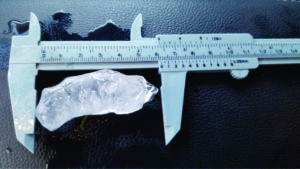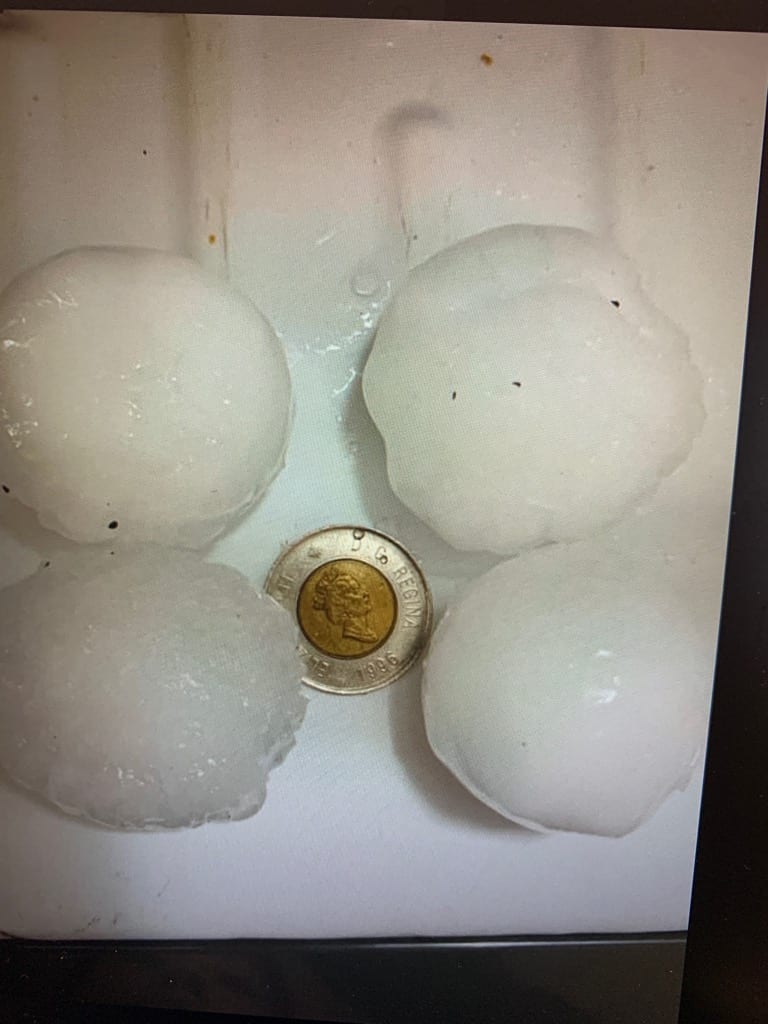Big Hail Stones, Big Problems
Welcome back.
Major hail damage is primarily caused by one of two factors: repetitive strikes or large hailstone size. Occasionally, the movement of a storm cell will be impeded by a high-pressure system or other natural phenomenon. When this happens, the entire fury of a hail storm can be released over a small swath of land, causing significant accumulation of hailstones. While there is no standard definition, some weather experts have proposed that hail accumulation exceeding 2-inches deep on flat, the open ground should be considered a “deep hail” event. At 2-inches hail depth, the landscape will resemble winter, with most lawns fully blanketed by hailstones.

Photo by: Kyle Brittan – The Weather network
Storms Producing Deep Hail Events
The type of storms producing deep hail events is often characterized by a high volume of smaller hailstones. These storms are of particular concern to crops and agriculture, but less damaging to vehicles and property. Property damage from deep hail events is typified by roof collapses (if accumulation is large enough) and damage caused by flash flooding from hail melt.

Photo by Kyle Brittan – The Weather Network
The Major Culprit
The major culprit of hail damage, the one to blame for dents in your car, broken windows, and premature hair loss in the insurance world, is severe hail. Much like deep hail, there is no definitive definition for “severe hail”, although a commonly accepted threshold is hailstones measuring at least one‑inch in diameter. The mass of these severe stones increases the terminal velocity (i.e., the peak free-fall velocity of a given object) and puts not only property but people in danger. A golf ball-sized hailstone, for instance, could eclipse a terminal velocity of 105 km/hr (65 mph), which is faster than the posted speed limit on your average highway.

The cause of severe hail is repetitive cycling in the cloud cell. As discussed in Part 1 of this series, a lifting force, or updraft, is one of the three criteria necessary for cumulonimbus clouds to form. Water droplets that have crystallized into hailstones in the cloud cell are pulled back towards the earth by gravity. Acting against them is that repetitive updraft force bringing more moisture into the cloud. As long as the force exerted by the updraft force exceeds the force of gravity, the hailstone will repeat a cycle of being pushed high in the cloud, starting its descent, only to be pushed upwards again. As this cycle repeats itself, additional moisture collects on the surfaces of the hailstones and freezes, causing them to grow in size. Each additional layer of ice increases the weight of the stone and the force of gravity acting on it. Repeating this growth pattern enough times is how Mother Nature produces the softball-sized abominations that make national news when they hit a populated area.
The bad news in all of this is that hail isn’t going anywhere; as sure as flowers bloom, and songbirds sing, springtime will bring hail. For owners of car dealerships, insurance premiums can cost hundreds of thousands of dollars if they have been a repeat victim of the annual hail season. Some owners have contacted us after they’ve reached the tipping point – when the cost of hail canopy is flat out cheaper than renewing their premiums. Others have hedged their bets against Mother Nature and reached while their premiums are still affordable. Regardless of the timing, if you are interested in effective hail protection, WeatherSolve has the technology and the resources to give you peace of mind. Drop us an email at info@weathersolve.com for any hail-related inquiries, or head over to our website if you want to learn more about our proprietary hail canopy system designed specifically for car dealerships and large vehicle storage lots.
Information regarding major hails storms and hail related records:
